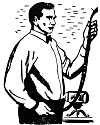|
As is so often the case with a new development, it brings along with it a special set of troubles. In this case it was the disadvantages of stripping off the collodion coating from the paper. Eastman wanted a material that would have all the advantages of the collodion-type film, but strong enough not to need the paper backing. It took another three years for Eastman and a chemist named Reichenbach to get a good transparent material.  In a laboratory in New Jersey another inventor was working with
photography. He wanted to take 15 or 20 pictures a second on a strip of
film, but he had been unable to find any such material until one day he
heard of Eastman's work. So he immediately wrote a letter to Rochester
enclosing $2.50 for a sample strip of the new material to be sent to T.
A. Edison, Orange, New Jersey. The new film, apparently, did the job
because in 1894 - fifty years ago, in an old shoe store on Broadway,
Thomas A. Edison exhibited the Kinetoscope. This was the beginning of
commercial motion pictures.
In a laboratory in New Jersey another inventor was working with
photography. He wanted to take 15 or 20 pictures a second on a strip of
film, but he had been unable to find any such material until one day he
heard of Eastman's work. So he immediately wrote a letter to Rochester
enclosing $2.50 for a sample strip of the new material to be sent to T.
A. Edison, Orange, New Jersey. The new film, apparently, did the job
because in 1894 - fifty years ago, in an old shoe store on Broadway,
Thomas A. Edison exhibited the Kinetoscope. This was the beginning of
commercial motion pictures. |








